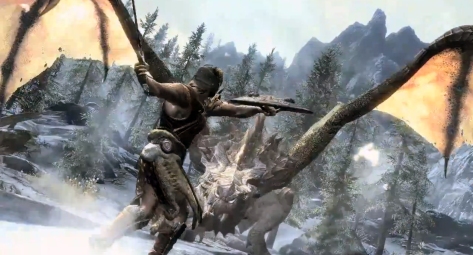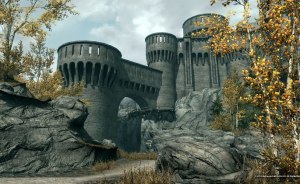
Maybe you’ve come here before and read one or more of my posts on Skyrim. If you haven’t, and you’re a parent interested in knowing more about the game, please also read my earlier review for parents. It would probably be better if you read that one first, actually, since it presents the positive aspects of the game. And just by way of warning, there are all kinds of spoilers in both posts.
I decided to write this not because I didn’t know about some unpleasant things about Skyrim before (though I know more now) – from a Christian perspective – but out of frustration over the questions presented on a major website. A great percentage of these questions show that a lot of young people like to play all of the bad aspects of the game, and miss the complexities. If you are a Christian and let your teen play without watching and knowing what they’re doing, maybe you’ll want to. My son hasn’t played lately, but when he did, he liked to play bad characters once to see what they were about. I didn’t like that he played some of the roles he had, but I talked with him about it. It gave me an opportunity to find out what he thought of things presented in the game, and if he did something bad in the game, how that might or might not reflect on his real-life actions and attitudes.
There are certain things that I really didn’t want him doing, and he didn’t – like selecting the perk where your character will be able to cut people’s heads off. This is bad enough in quick game play, but in Skyrim slow-motion, close-up cut-scenes happen randomly and they would include the slicing off of heads. If a parent is concerned about what their child can select as perks, they can easily see all available perks from the perk trees, viewable after selecting the Skills menu.
The problem with Skyrim is that it is made by a corporation seeking the largest possible market (the Elder Scrolls series did not start out this way, and previous games were more specifically moral). While the Dovahkiin – your character, the Dragonborn – is SUPPOSED to be a good SAVIOR type of figure, the player can choose to do all kinds of evil things. Not only that, but there is quite a bit more to do in the game if the player decides to do these bad things. Please watch the video below to hear the theme song, which is awesome, and read the words of the song. They talk of the character of the Dovahkiin and of the main quest of the game (though there is a secondary main quest too).
As a parent, you may want to know more specifically about what I’m talking of in order to decide if you want to limit your kid’s game play in these areas.
1) The Thieves Guild. In past Elder Scrolls games, the Thieves Guild was more like a Robin Hood sort of organization. In Skyrim it is not, and it is controlled by Mavin Blackbriar, a super evil, powerful, business woman who has a whole heck of a lot people fooled. The most disturbing thing about Skyrim, when I first started playing, was finding out that you cannot get rid of Mavin and stop her murders and mafia-like activities in Riften – even though it seems like the game-makers intended to let you do something. By the way the characters in Riften talk, and by the notes you find, it seems as though bringing Mavin to justice will be a quest . . . but in the end you can’t do anything about her. In any case, there are lots of quests to do with the Thieves Guild and lots of items unique to the guild to be had, so it would be tempting to a lot of people to be in this guild.
2) The Dark Brotherhood. These are assassins for hire. Mavin is in with them too. You get the picture. Again, quests and loot . . . so it’s tempting to play as a bad guy.
3) Vampires. The Dawnguard expansion allows the player to be a vampire, but the main idea is to be a part of the Dawnguard – vampire slayers. The castle with the vampires is pretty disgusting and I think the game makers did an OK job of making vampires a negative thing, while still providing a mass-market expansion. Vampires of course feed on humans.
4) Werewolves and the Companions. Being a werewolf in Skyrim can be only a matter of being stronger once a day, but there is the option to feed off of a human (cannibalism) in order to maintain the form a bit longer. With the Dawngaurd expansion, however, it can get nastier. Dawnguar adds a werewolf perk tree, and unlike the other perk trees, perks can only be ge gained by eating human hearts. Yeah, gross. There is a non-Companions quest in Skyrim that conveys the evilness of lycanthropy. I not only included the Companions here because it is the group where you acquire lycanthropy, but I wanted to mention the less than charitable intentions of the Companions. They only do good works if they’re paid, and one gets the impression that the more they are paid, the more likely they will be to go out and actually do the job. A good thing about the Companions is that you get the opportunity to cure the leader of his werewolfism, which he very much desires.
As discussed in my original review, Skyrim is a complex game if played the way it was meant to be played. One quest that I found to be bad, that seems like a good thing to do at first, is the Gildergreen quest. In this quest, you are to recover an evil blade (hey, a clue there), which is needed in order to collect the sap of a certain tree. The reason you need this sap is to revive the Gildergreen tree in Whiterun. Before you revive it, it looks dead; afterwards it looks alive and vibrant, with purple flowers. So WHY would that be a bad thing? Well, you wouldn’t really know at first.
The first hint is the evil blade, but then, a lot of things in Skyrim are just things and don’t necessarily live up to their names. But there is another hint. When you go to where the mother tree is, which is in a very large, beautiful, and tranquil lit cavern, you encounter some people there enjoying the sanctuary. When you talk with the lady there, you can ask her about the tree and the blade, and she responds very negatively to you. Ok. So . . . what do you do? It doesn’t seem that bad or anything – you just want to revive the tree in Whiterun. But what happens, no matter how hard you try to control the situation, is that the persons in the sanctuary get killed by the guardian Spriggons when you cut the mother tree for its sap. Is reviving an old tree in Whiterun worth the lives of those people? Not in my book. The Whiterun folks can get a new tree!
I think the Gildergreen quest is actually a good lesson in deciphering information and choosing to do the better thing. Skyrim is full of mental and moral exercises such as the Gildergreen quest. A problem with this, however, as with the evil groups and quests in Skyrim generally, is that the player must choose not to do a lot of available game play. As an adult I’m not very tempted to join the evil groups and do evil things, but for a lot of young people these might be tempting (especially in the presence of peer pressure). I do think Skyrim has A LOT going for it compared to other games: visual and musical beauty, complexity (good luck trying to decipher all the purposefully conflicting books and dialogue regarding the history and religion of not only Skyrim, but that of the continent it’s on, Tamriel), historical and mythological aspects, etc. As a Christian parent, I think it’s OK for older kids to play as long as the parent(s) knows about the game and is at least somewhat involved with their kid’s gameplay.
[Section on lycanthropy updated on Jan. 23, 2013]






